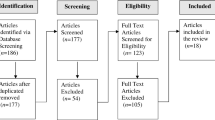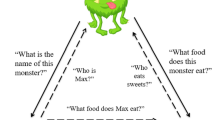Abstract
This applied study attempted to evaluate a combination of transfer procedures commonly used to teach tacts to children with autism. A receptive to echoic to tact transfer and an echoic to tact transfer procedure were combined during 5-min instructional sessions to teach tacts to a seven-year-old vocal child with autism. A multiple baseline design across three sets of ten tacts was used. Without the teaching procedure, the child acquired no target tacts. With the 5-min teaching procedure implemented first with Set 1 then with Sets 2 and 3, respectively, the child acquired thirty new tacts over sixty teaching sessions. The results have wide application for children with and without autism who need instruction to learn tacts.
Similar content being viewed by others
References
Cooper, J. O., Heron, T. E., & Heward, W. L. (1987). Applied behavior analysis. Columbus, OH: Merrill.
Drash, P. W., High, R. L. & Tudor, R. M. (1999). Using mand training to establish an echoic repertoire in young children with autism. The Analysis of Verbal Behavior, 16, 29–44.
Lovaas, O.L. (2002). Teaching individuals with developmental delays. Austin, TX: Pro-Ed.
Lowenkron, B. (2004). Meaning: A verbal behavior account. The Analysis of Verbal Behavior, 20, 77–97.
Sundberg, M. L., & Partington J. W. (1998). Teaching language to children with autism or other developmental disabilities. Pleasant Hills, CA: Behavior Analysts.
Sundberg, M. L., Endicott, K., & Eigenheer, P. (2000). Using intraverbal prompts to establish tacts for children with autism. The Analysis of Verbal Behavior, 17, 89–104.
Skinner, B. F., (1957). Verbal behavior. Englewood Cliffs, NJ: Prentice Hall.
Terrace, H. (1963). Discrimination learning with and without “errors.” Journal of the Experimental Analysis of Behavior, 6, 1–27.
Touchette, P. E. & Howard, J. S. (1984). Errorless learning: Reinforcement contingencies and stimulus control transfer in delayed prompting. Journal of the Applied Behavior Analysis, 17(2), 175–188.
Wolery, M, Ault, M. J., & Doyle, P.M. (1992). Teaching students with moderate to severe disabilities. White Plains, NY: Longman.
Author information
Authors and Affiliations
Corresponding author
Rights and permissions
About this article
Cite this article
Barbera, M.L., Kubina, R.M. Using Transfer Procedures to Teach Tacts to a Child with Autism. Analysis Verbal Behav 21, 155–161 (2005). https://doi.org/10.1007/BF03393017
Published:
Issue Date:
DOI: https://doi.org/10.1007/BF03393017




